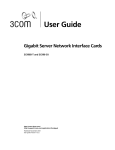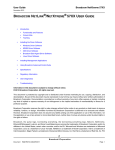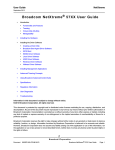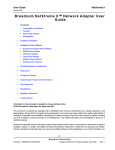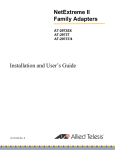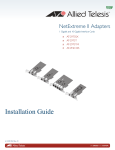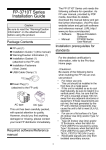Download Wake-on-LAN (WOL) Support on Dell™ Servers
Transcript
Wake-on-LAN (WOL) Support on Dell™ Servers Dell White Paper By Ken Bignell [email protected] October 2007 Contents Introduction............................................................................................................................... 3 Definition ............................................................................................................................ 3 Prerequisites ....................................................................................................................... 3 Tools ................................................................................................................................................... 3 Dell Servers that Support Wake‐on‐LAN ..................................................................... 3 Supported NICs (Network Adapters) ........................................................................................... 4 Supported Operating Systems ........................................................................................................ 5 Using WOL after A/C Power Disconnect or with no Operating System (OS) Installed (Out‐of‐Box, or D0uninitialized) ........................................................................................... 6 Enabling WOL under Microsoft Windows NT 4.0............................................................. 8 Enabling WOL under Microsoft Windows 2000 Server or Microsoft Server 2003 Family Operating Systems.................................................................................................... 10 Enabling WOL under Red Hat Enterprise Linux® versions 4 and later and SUSE® Linux Enterprise Server versions 9 and later .................................................................... 12 Enabling WOL under Novell® NetWare® 5.x and 6.x .................................................... 14 October 2007 Page 2 Dell Enterprise Product Group Section 1 Introduction This paper provides step‐by‐step instructions for using Wake‐On‐LAN (WOL) with Dell™ Servers. Definition Wake‐On‐LAN allows a server to be remotely powered on. Wake‐On‐LAN technology resides in a server’s managed network interface card (NIC) and/or in a LAN‐on‐motherboard (LOM) integrated network connection. When a WOL enabled system is placed in a power saving mode (hibernate, standby, power off, etc...), the managed NIC or LOM uses the auxiliary power source to monitor the network and receive a wake‐up packet. When a wake‐up packet is received, the system powers up as normal. Prerequisites Tools The following tools are necessary to have on hand before using wake‐on‐LAN on a Dell server: 1. DOS bootable floppy disk, MS DOS version 6.0 or newer, FreeDOS or DRDOS (APM WOL only.) 2. IBAUTIL.EXE version 4.02.02.01 or newer for Intel network interface cards (NICs) or Intel‐based LANs on Motherboard (LOMs). 3. B57UTIL.EXE version 10.11 or newer or B57UDIAG.EXE version 6.04 or newer for Broadcom NICs or Broadcom‐based LOMs. 4. UXdiag.exe version 1.3.1 or newer for Broadcom NetXtreme II NICs or LOMs. 5. Ethtool 1.8.4 or better for Linux WOL (Dell Servers support Red Hat Enterprise Linux® and SUSE® Enterprise distributions of Linux.) 6. The latest BIOS for each system to use WOL. October 2007 Page 3 Dell Enterprise Product Group Dell Servers that Support Wake-on-LAN The following are the Dell servers that support wake‐on‐LAN, and to what extent: • WOL is only supported on the LOM(s) (LAN on motherboard or integrated [embedded] NIC) o PowerEdge™ 350 o PowerEdge 1550 o PowerEdge 6400 o PowerEdge 6450 • • • WOL is supported on the LOM(s) and in all slots with a WOL‐supported NIC o PowerEdge 500 o PowerEdge 600 o PowerEdge 1400 o PowerEdge 1600SC o PowerEdge 1650 o PowerEdge 1750 Broadcom NICs may cause the system to not boot if WOL is enabled for them in a slot in this system due to the larger amount of current drawn by them when in a WOL state. o PowerEdge 2400 o PowerEdge 2450 o PowerEdge 2500 o PowerEdge 2550 WOL is not supported on the Gigabit LOM o PowerEdge 2600 o PowerEdge 2650 o PowerEdge 4400 o PowerEdge 4600 o PowerEdge 7150 WOL is not supported on the LOM but is in all slots with a WOL‐ capable NIC o PowerEdge 1500 All Dell Servers except blade systems newer than 2006 support WOL on both LOMs and in slots with WOL‐capable NICs. Supported NICs (Network Adapters) The following are the NICs available for Dell servers that support WOL: • Intel® PRO/100 + Server Adapter, Dell Part Number – 3710T • Intel PRO/100 S Secure Server Adapter, Dell Part Number – 6745U • Intel PRO/100 S Server Adapter, Dell Part Number – 8G779 • Intel PRO/1000XT Gigabit Server Adapter, Dell Part Number – 0X885 October 2007 Page 4 Dell Enterprise Product Group • Intel PRO/1000MT Single Port Gigabit Server Adapter, Dell Part Number – W1392 • Intel PRO/1000MT Dual Port Gigabit Server Adapter, Dell Part Number – • Intel 1000PT Single Port Gigabit Server Adapter, Dell Part Number – U3867 • Intel 1000PT Dual Port Gigabit Server Adapter, Dell Part Number – X3959 • Broadcom NetXtreme Gigabit Adapter, BCM5700, Dell Part Number – 063MY • Broadcom NetXtreme Gigabit Adapter, BCM5701, Dell Part Number – 1H984 • Broadcom NetXtreme Gigabit Adapter, BCM5703, Dell Part Number – 4R672 • Broadcom NetXtreme Gigabit Adapter, BCM5721, Dell Part Number – HF692 • Broadcom NetXtreme Gigabit Adapter, BCM5722, Dell Part Number – XK104 • Broadcom NetXtreme II Gigabit Adapter, BCM5708, Dell Part Number – TX564 Note: Dell Part Numbers may change over time, consult the latest NIC User Guide documentation for WOL support for NICs not listed here. Supported Operating Systems • • • • • • • No Operating System Installed Microsoft® Windows NT® 4.0 Server Family The Microsoft Windows NT 4.0 Server family is not ACPI compliant; the driver must set up WOL. Microsoft Windows Server® 2000 Family Microsoft Windows 2000 is ACPI (Advanced Configuration and Power Interface) compliant and supports WOL from Hibernate and Standby. Dell servers support the Hibernate mode and not the Standby mode, with the exception of the PowerEdge 350, which supports Standby and not Hibernate. Microsoft Windows Server 2003 and 2008 (when available) Families Microsoft Windows Server 2003 is ACPI (Advanced Configuration and Power Interface) compliant and supports WOL from Hibernate and Standby. Dell servers support the Hibernate mode and not the Standby mode, with the exception of the PowerEdge 350, which supports Standby and not Hibernate. Red Hat® Enterprise Linux® versions 4 and newer Linux is not currently ACPI compliant and WOL must be set up by the driver or another agent. SUSE® Linux Enterprise Server versions 9 and newer Linux is not currently ACPI compliant and WOL must be set up by the driver or another agent. Novell® NetWare® 5.x and 6.0 NetWare is not ACPI compliant and WOL must be set up by the driver. October 2007 Page 5 Dell Enterprise Product Group Section 2 Using WOL after A/C Power Disconnect or with no Operating System (OS) Installed (Out-of-Box, or D0uninitialized) Dell’s NICs and LOMs can accomplish WOL after a system has been unplugged from all A/C power, then returned to A/C power, but not powered on. This state is known as “Out‐Of‐Box WOL” or “D0uninitialized.” This can be useful if servers to be installed pass through a central processing point for preparation, and then are installed at a remote site. NICs and LOMs from Dell have WOL disabled by default. Having more than one device enabled for WOL in a system can overload the 3.3‐volt auxiliary power supply and cause it to malfunction. Dell strongly recommends that only one device be enabled for WOL per system. To enable Out‐of‐Box WOL, create a DOS‐bootable floppy and copy the utility, listed in the Tools section above, specific to the WOL device to it from the Dell Open Management Server Assistant or download it from http://support.dell.com. Note: Broadcom B5700 and B5701 based NICs and LOMs do not support WOL in this way. The steps to enabling WOL after A/C power disconnect or with no operating system are as follows: 1. Boot the system using the DOS floppy, and run ‘IBAUTIL.EXE’, ‘UXDIAG.EXE –t ABCD’ or ‘B57UDIAG.EXE –t ABCD’. These programs will display the physically installed adapters and the status of each card’s WOL setting. UXDIAG.EXE is for NetXtreme II devices and B57UDIAG.EXE is for NetXtreme I devices. 2. Choose the NIC for WOL, record its MAC address, and note its number on the left hand side of the display. a. Enable Intel WOL by typing ‘ibautil –nic=X –wole’ where X is the number of the NIC in the display. b. Enable Broadcom NX1 WOL by typing ‘b57udiag –w 1 –c X’ where X is the number of the NIC in the display. c. Enable Broadcom NX2 WOL by typing ‘uxdiag –c X –wol 1’ where X is the number of the NIC in the display. October 2007 Page 6 Dell Enterprise Product Group 3. 4. October 2007 Unplug the system and send it to the remote site to be installed. The system must be removed from all A/C input for a period of at least 10 seconds to allow all capacitance to drain from the system so it resets to its default state. The system must not be powered on, just connected to A/C and the WOL enabled NIC connected to the active network. The system is now ready to be powered on via WOL when needed. Send a ‘Magic Packet’ wake up signal to the MAC address of the WOL enabled NIC, and the system will boot. Out‐of‐Box WOL can only be accomplished via the ‘Magic Packet’ WOL signal. Page 7 Dell Enterprise Product Group Section 3 Enabling WOL under Microsoft Windows NT 4.0 NICs and LOMs from Dell have WOL disabled by default. Having more than one device enabled for WOL in a system can overload the 3.3‐volt auxiliary power supply and cause it to malfunction. Dell strongly recommends that only one device be enabled for WOL per system. To enable WOL, create a DOS‐ bootable floppy and copy the utility, listed in the Tools section above, specific to the WOL device to it from the Dell Open Management Server Assistant or download it from http://support.dell.com. The steps to enabling WOL under Windows NT 4.0 are as follows: 1. Boot the system using the DOS floppy, and run ‘IBAUTIL.EXE’, ‘UXDIAG.EXE –t ABCD’ or ‘B57UDIAG.EXE –t ABCD’. These programs will display the physically installed adapters and the status of each card’s WOL setting. UXDIAG.EXE is for NetXtreme II devices and B57UDIAG.EXE is for NetXtreme I devices. 2. Choose the NIC for WOL, record its MAC address, and note its number on the left hand side of the display. a. Enable Intel WOL by typing ‘ibautil –nic=X –wole’ where X is the number of the NIC in the display. b. Enable Broadcom NX1 WOL by typing ‘b57udiag –w 1 –c X’ where X is the number of the NIC in the display. c. Enable Broadcom NX2 WOL by typing ‘uxdiag –c X –wol 1’ where X is the number of the NIC in the display. 3. Reboot the system and login to Windows NT 4.0 with an account that has administrator privileges. If the most recent Dell‐provided drivers are not installed, install them. Dell strongly suggests updating to the newest versions of the network drivers available on the Dell support web site. 4. For Broadcom NICs and LOMs, or Intel Gigabit (1000 MBps) NICs or LOMs, skip to step 9. For Intel FastEthernet (10/100 Mbps) NICs or LOMs, from the system tray or from the control panel, open PROSet II. Click on the NIC with WOL 5. October 2007 Page 8 Dell Enterprise Product Group enabled. The displayed Ethernet Address will match the MAC address obtained while using IBAUTIL.EXE. 6. Choose the Advanced Tab. In the settings frame, choose Enable PME and change the value to Enabled. 7. Click OK. Windows NT 4.0 will prompt for a reboot. Choose Yes. 8. After the system has restarted, if the NIC is not already connected to a switch or hub, connect it and shut the system down. 9. Shut the system off. The connection LED on the NIC and switch or hub will remain on indicating the NIC is monitoring the network for wake up packets directed to its MAC address. 10. Send a wake up signal to the MAC address of the WOL enabled NIC, and the system will boot. Note: If the system boot is interrupted before the OS and the NIC driver are loaded, the system will not be able to perform WOL again until the system is rebooted manually and the OS and driver are allowed to load and reset the NIC’s WOL registers. October 2007 Page 9 Dell Enterprise Product Group Section 4 Enabling WOL under Microsoft Windows 2000 Server or Microsoft Server 2003 Family Operating Systems NICs and LOMs from Dell have WOL disabled by default. Having more than one device enabled for WOL in a system can overload the 3.3‐volt auxiliary power supply and cause it to malfunction. Dell strongly recommends that only one device be enabled for WOL per system. To enable WOL follow the steps below. The steps to enabling WOL under Windows 2000 Server and Windows Server 2003 operating systems are as follows: 1. Windows 2000 and Windows 2003 do not require that WOL be turned on in the NIC’s or LOM’s firmware, therefore the steps using DOS outlined in the Out‐of‐Box and Windows NT 4.0 procedures are not necessary and should be skipped. Enabling WOL with IBAUTIL.EXE, UXDIAG.EXE or B57UDIAG.EXE may be detrimental to WOL under Windows 2000 and Windows 2003. 2. Login to Windows 2000/2003 with an account that has administrator privileges. If the most recent Dell provided drivers for the NIC are not installed, install them. Open the properties for the NIC enabled for WOL and then click the ‘Configure’ button. Choose the Power Management Tab and enable the check box next to the line ‘Allow this device to bring the computer out of standby.’ Standby in this case refers to both Standby and Hibernate. Ensure that the check box next to the line ‘Allow the computer to turn off this device to save power’ is also checked. 3. Ensure Hibernate is enabled for the system by opening Power Options in the Control Panel, choosing the Hibernate Tab and checking ‘Enable hibernate support’. (See Note below if using a PowerEdge 350.) 4. Click OK. 5. If the NIC is not already connected to a switch or hub, connect it and set the system to hibernate by clicking Start/Shutdown and choosing Hibernate. October 2007 Page 10 Dell Enterprise Product Group 6. 7. The system will shut off. The connection LED on the NIC and switch or hub will remain on indicating the NIC is monitoring the network for wake up packets directed to its MAC address. Send a wake up signal to the MAC address of the WOL enabled NIC, and the system will boot. Note: If the system boot is interrupted before the operating system (OS) and the NIC driver are loaded, the system will not be able to perform WOL again until the system is rebooted manually and the OS and driver are allowed to load and reset the NIC’s WOL registers. PowerEdge 350 Note: The PowerEdge350 is the only Dell server that supports Standby and not Hibernate. The same procedures should be followed with the exception of the Hibernate enabling step and the shutdown to hibernate. Standby is enabled by default. Send the system in to standby by clicking Start/Shut Down then choosing Standby. October 2007 Page 11 Dell Enterprise Product Group Section 4 Enabling WOL under Red Hat Enterprise Linux® versions 4 and later and SUSE® Linux Enterprise Server versions 9 and later NICs and LOMs from Dell have WOL disabled by default. Having more than one device enabled for WOL in a system can overload the 3.3‐volt auxiliary power supply and cause it to malfunction. Dell strongly recommends that only one device be enabled for WOL per system. To enable WOL, create a DOS‐ bootable floppy and copy the utility, listed in the Tools section above, specific to the WOL device to it from the Dell Open Management Server Assistant or download it from http://support.dell.com. The steps to Enabling WOL under Red Hat Enterprise Linux versions 4 and later and SUSE Linux Enterprise Server versions 9 and later are as follows: 1. Login to the BASH shell with root privileges. If the most recent Dell provided drivers are not installed, install them. Run ‘ethtool ethX’ where ‘ethX’ is the name and instance of the desired WOL network interface. The WOL capabilities and current default settings will be displayed in the output. a. The ethtool man pages have more information on settings and meanings of the settings. b. If the default settings show WOL disabled (as they will by default as shipped from Dell) then following steps 1 and 2 in the Out‐of‐Box WOL instruction section will change the default setting. c. Enabling WOL with ethtool when the default is disabled will not persist across reboots, meaning that shutting down and performing WOL once, then shutting down again and attempting WOL will not be successful without running ethtool again to enable WOL. The use of a startup script can enable WOL on each subsequent reboot if desired, or changing the default from the DOS based utilities. 2. Run ‘ethtool ethX –s wol g’ to enable Magic Packet WOL, where ethX is the name and instance of the desired WOL network interface. 3. Halt Linux and shut the system off. The connection LED on the NIC and switch or hub will remain on, indicating the NIC is monitoring the network for wake up packets directed to its MAC address. October 2007 Page 12 Dell Enterprise Product Group a. 4. To enable wake up types other than Magic Packet, check the ethtool man pages. Send a Magic Packet wake up signal to the MAC address of the WOL enabled NIC, and the system will boot. Note: If the system boot is interrupted before the OS and the NIC driver are loaded, the system will not be able to perform WOL again until either the system is rebooted manually and the OS and driver are allowed to load and reset the NICs WOL registers, or A/C power to the system is removed for at least 30 seconds, resetting the NIC’s WOL registers. October 2007 Page 13 Dell Enterprise Product Group Section 3 Enabling WOL under Novell® NetWare® 5.x and 6.x NICs and LOMs from Dell have WOL disabled by default. Having more than one device enabled for WOL in a system can overload the 3.3‐volt auxiliary power supply and cause it to malfunction. Dell strongly recommends that only one device be enabled for WOL per system. To enable WOL, create a DOS‐ bootable floppy and copy the utility, listed in the Tools section above, specific to the WOL device to it from the Dell Open Management Server Assistant or download it from http://support.dell.com. The steps to enabling WOL under NetWare 5.x and 6.x are as follows: 1. Boot the system using the DOS floppy, and run ‘IBAUTIL.EXE’, ‘UXDIAG.EXE –t ABCD’ or ‘B57UDIAG.EXE –t ABCD’. These programs will display the physically installed adapters and the status of each card’s WOL setting. UXDIAG.EXE is for NetXtreme II devices and B57UDIAG.EXE is for NetXtreme I devices. 2. Choose the NIC for WOL, record its MAC address, and note its number on the left hand side of the display. a. Enable Intel WOL by typing ‘ibautil –nic=X –wole’ where X is the number of the NIC in the display. b. Enable Broadcom NX1 WOL by typing ‘b57udiag –w 1 –c X’ where X is the number of the NIC in the display. c. Enable Broadcom NX2 WOL by typing ‘uxdiag –c X –wol 1’ where X is the number of the NIC in the display. 3. 4. Reboot the system and start the NetWare server. If the most recent Dell‐ provided drivers are not installed, install them. For Intel based NICs or LOMs no modification is necessary, the driver is set up for WOL by default. To turn off WOL, use the ‘pmedisable=1’ key word in the load line. Set ‘pmedisable=0’ to re‐enable WOL 5. October 2007 For Broadcom based NICs or LOMS, the keyword ‘magicp=1’ must be used to enable the driver for WOL. Setting ‘magicp=0’ disables WOL, disabled is the default. Page 14 Dell Enterprise Product Group 6. 7. 8. Restart the server. After the server has restarted, if the NIC is not already connected to a switch or hub, connect it and shut the server down. Shut the system off. The connection LED on the NIC and switch or hub will remain on indicating the NIC is monitoring the network for wake up packets directed to its MAC address. Send a wake up signal to the MAC address of the WOL enabled NIC, and the system will boot. Note: If the system boot is interrupted before the OS and the NIC driver are loaded, the system will not be able to perform WOL again until the system is rebooted manually and the OS and driver are allowed to load and reset the NIC’s WOL registers. ©Copyright 2003‐2008 Dell Computer Corporation. All rights reserved. Reproduction in any manner whatsoever without the express written permission of Dell Computer Corporation is strictly forbidden. For more information, contact Dell. Dell cannot be responsible for errors in typography or photography. Trademarks used in this text: Dell, PowerEdge, and OpenManage are trademarks of Dell, Inc.; Microsoft, Windows, Windows NT, and Windows Server are registered trademarks of Microsoft; Intel is a registered trademark of Intel Corporation.; Red Hat and Red Hat Enterprise Linux are registered trademarks of Red Hat, Inc.; Novell and NetWare are registered trademarks of Novell, Inc.; SUSE is a registered trademark of SUSE Linux Products GmbH. Other trademarks and trade names may be used in this document to refer to either the entities claiming the marks and names or their products. Dell disclaims any proprietary interest in trademarks and trade names other than its own. Information in this document is subject to change without notice. The content is provided as is, without express or implied warranties of any kind. October 2007 Page 15 Dell Enterprise Product Group
















